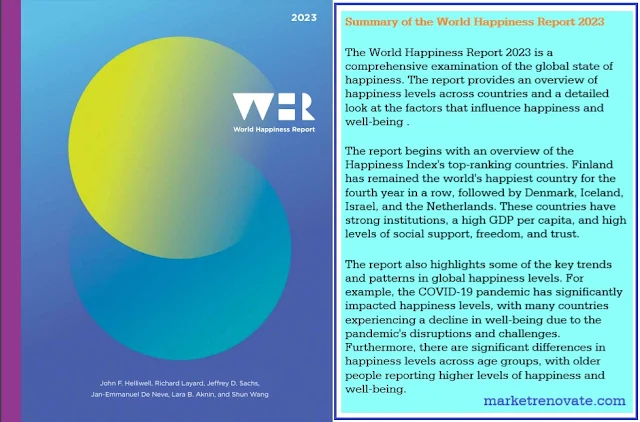Understanding the Happiness Index
The Happiness Index, also known as the World Happiness Report, is an annual report that measures people’s subjective well-being in various countries around the world. The Sustainable Development Solutions Network first published the report in 2012 (Source). It has become a valuable resource for policymakers, researchers, and individuals interested in discovering what makes people happy and how we can promote greater happiness.
One of the key findings of the Happiness Index is that money alone does not make people happy. While income and happiness have a positive relationship, it is not a straight line. Other factors that influence happiness include social support, freedom, and trust. For example, people in countries with high levels of social support and trust report higher levels of happiness, even if their income levels are lower.
Another significant finding from the Happiness Index is that there are significant differences in happiness levels across countries, with some consistently ranking higher than others.
According to a recent World Happiness report in 2023, the Happiness Index’s top-ranking countries are Finland, Denmark, Iceland, Israel, the Netherlands, Sweden, and Norway, with Afghanistan at the bottom of the list. Unlike its regional neighbor India, Nepal fared significantly better on the Happiness Index, ranking 78th in the world. India, on the other hand, is ranked 126th, trailing countries in the region, such as Pakistan (108), Sri Lanka (112), Myanmar (117), Bangladesh (118), and Nepal (78).
The report also identifies some key factors that contribute to these countries’ high levels of happiness, such as strong social support networks, trust, and generous culture.
Calculation of The Happiness Index
The World Happiness Report, also known as the Happiness Index, is calculated by measuring subjective well-being using a variety of factors. These factors are based on survey responses from people in various countries who were asked to rate their level of happiness on a scale of 0 to 10, with 10 representing the highest level of happiness possible.
The Happiness Index is calculated using factors such as income, social support, freedom, trust, generosity, and health. Each of these factors is assigned a score based on the survey responses from each country. These scores are then added together to produce an overall score for each country, which is used to rank countries based on their average levels of happiness.
The survey responses are first standardized to a range of 0 to 1, with 1 representing the highest possible score, before the scores for each factor are calculated. For example, the income factor is based on each country’s average level of income, which is then standardized to a range of 0 to 1. Similarly, the social support factor is based on each country’s perceived availability of social support, which is also standardized on a scale of 0 to 1.
After each factor’s scores have been standardized, they are weighted based on their importance in contributing to overall well-being. The weights are based on research into the factors most closely associated with happiness and well-being. Social support and freedom, for example, may be given higher weights than income because they have been found to have a stronger association with happiness and well-being.
Finally, the weighted scores for each factor are added together to generate an overall score for each country, which is used to rank countries based on average happiness levels. The highest-ranking countries have the highest overall scores, indicating the greatest levels of subjective well-being.
- National Income (NI) and its Measurement
- NNP and its Measurement Methods
- Differences between GDP and GNP
- GNP and its Measurement Methods
- GDP and its Measurement Methods
- Personal Income (PI) and its Measurement
- Disposable Personal Income (DPI) and its Measurement
- Differences Between Personal Income and Disposable Personal Income
- PCI and its Measurement
- Happiness Index and its Measurement
- PQLI (Physical Quality of Life Index) and its Measurement
- HDI and its Measurement
Importance of the Happiness Index
The Happiness Index is useful for assessing subjective well-being and learning about the factors that influence happiness and well-being. The Happiness Index is significant for the following reasons:
- Gives a comprehensive view of well-being: The Happiness Index goes beyond traditional measures of well-being, such as income and GDP, to provide a more holistic perspective on well-being, such as income and GDP, to provide a more holistic perspective on well-being. The Happiness Index provides a more comprehensive understanding of what contributes to happiness and well-being by incorporating social support, freedom, trust, generosity, and health factors.
- Allows for cross-country comparisons: The Happiness Index allows happiness levels to be compared across countries. This is useful for identifying patterns and trends in happiness levels and understanding the factors that contribute to happiness and well-being in various contexts.
- Can guide decision-makers: The Happiness Index can provide valuable insights into the factors contributing to happiness and well-being, which can help policymakers make better decisions. For example, if social support is discovered to be a significant contributor to happiness, policymakers may prioritize policies that encourage the formation of strong social networks.
Limitations of the Happiness Index
Despite its importance, the Happiness Index also has several limitations that should be considered before using it:
- Data subjectivity: The Happiness Index is based on self-reported data, which can be biased and variable. Individuals’ definitions of happiness may differ, and cultural factors may influence how people respond to the survey question.
- The limited scope of factors: The Happiness Index incorporates a variety of factors that contribute to well-being, but it may not capture all of the factors that are important to individuals. For example, the survey question may not fully capture factors such as meaningful work or spiritual fulfillment.
- Lack of causality: The Happiness Index provides insights into the factors associated with happiness and well-being but does not establish causality. Happiness may lead to more social support rather than the other way around.
Summary of the World Happiness Report 2023
The World Happiness Report 2023 is a comprehensive examination of the global state of happiness. The report provides an overview of happiness levels across countries and a detailed look at the factors that influence happiness and well-being (Download the report).
The report begins with an overview of the Happiness Index’s top-ranking countries. Finland has remained the world’s happiest country for the fourth year in a row, followed by Denmark, Iceland, Israel, and the Netherlands. These countries have strong institutions, a high GDP per capita, and high levels of social support, freedom, and trust.
The report also highlights some of the key trends and patterns in global happiness levels. For example, the COVID-19 pandemic has significantly impacted happiness levels, with many countries experiencing a decline in well-being due to the pandemic’s disruptions and challenges. Furthermore, there are significant differences in happiness levels across age groups, with older people reporting higher levels of happiness and well-being.
The report also includes a detailed examination of the factors that influence happiness and well-being. These factors include social support, freedom, trust, generosity, and health. The report emphasizes the importance of investing in these factors to promote happiness and well-being and suggests that policymakers prioritize policies that encourage the formation of strong social networks, promote economic freedom, and improve access to healthcare and other basic needs.
However, the report acknowledges the Happiness Index’s limitations and difficulties in measuring subjective well-being. The report shows various factors can influence self-reported happiness levels, including cultural differences, social norms, and individual personality traits. Furthermore, due to social desirability bias or a desire to present themselves in a positive light, some people may be more likely to report higher levels of happiness.
Furthermore, the Happiness Index is based on subjective measures of happiness, which may not always correspond to objective life quality measures. For example, a country with high economic development may rank lower on the Happiness Index if its citizens report lower levels of subjective well-being.
Reference
Helliwell, J. F., Layard, R., Sachs, J. D., Aknin, L. B., De Neve, J.-E., & Wang, S. (Eds.). (2023). World Happiness Report 2023 (11th ed.). Sustainable Development Solutions Network. https://worldhappiness.report/ed/2023/







Please leave your comments or ask your queries here. The comments shall be published only after the Admin approval.